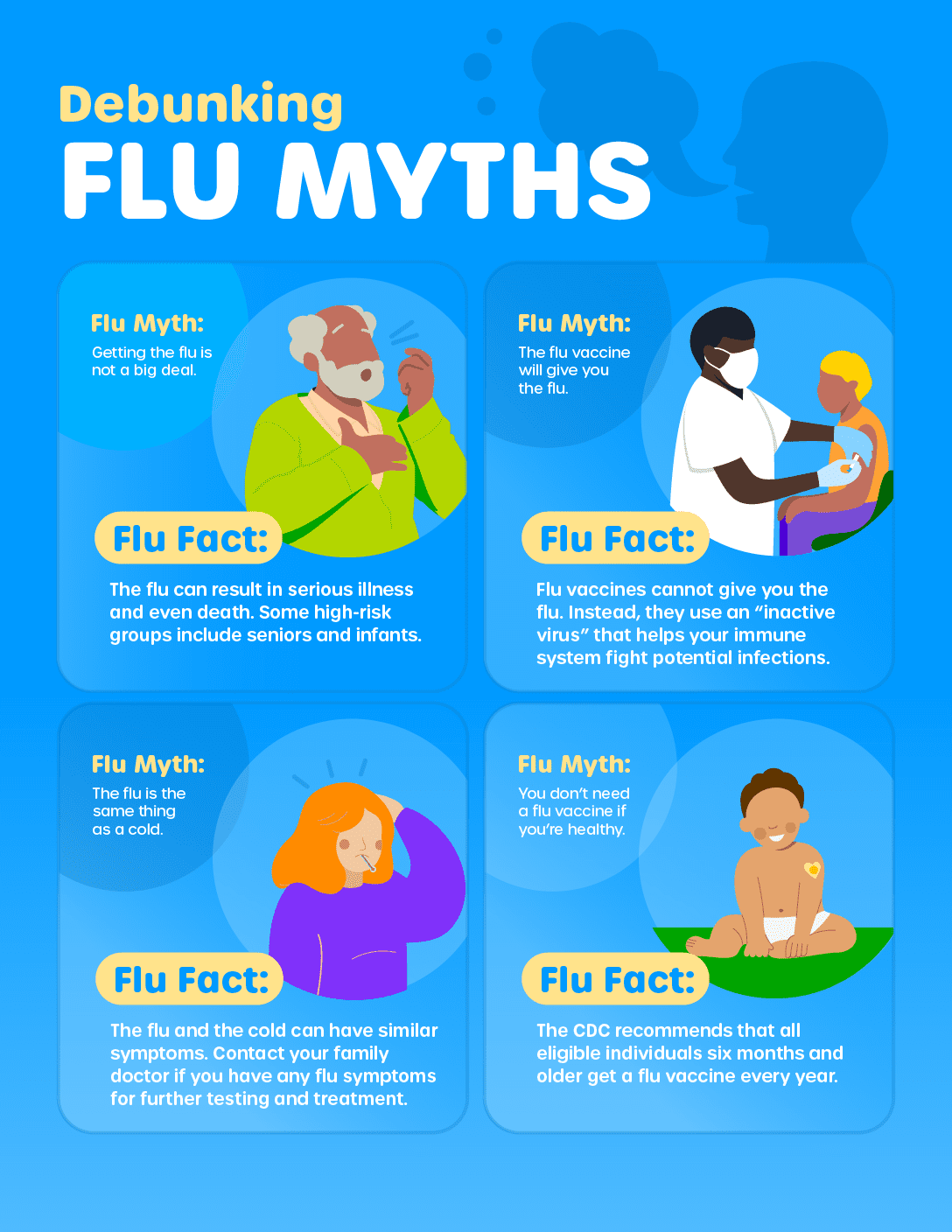Preparing for Flu Season: Tips to Stay Healthy and When to Visit the ER
Understanding Flu Season
Flu season marks a period when respiratory illnesses, like respiratory illnesses, become particularly prevalent, with a peak often observed during the colder months of fall and winter. This season profoundly impacts the United States, with influenza cases ranging from 9 million to 41 million annually, underscoring the virus’s pervasive reach and potential for widespread health implications. The simultaneous circulation of multiple influenza strains, notably A(H1N1)pdm09 and A(H3N2), is frequently observed, with specific regional variations that influence the spread and severity of outbreaks.
The onset of flu activity typically begins in October, with a notable spike between December and February, although these patterns can fluctuate based on various environmental and societal factors. To effectively manage and respond to these fluctuations, the CDC employs the National Respiratory and Enteric Virus Surveillance System (NREVSS). This sophisticated system is instrumental in tracking viral activity across the nation, offering crucial data that informs public health strategies and interventions aimed at mitigating the impact of flu season. By understanding these trends and the dynamics of viral transmission, communities can better prepare and adapt to the challenges posed by flu season each year.
Importance of Flu Vaccination
Getting vaccinated against the flu is one of the most effective ways to safeguard your health during flu season, as it significantly reduces the likelihood of contracting the virus. Annual flu vaccinations can lower the risk of flu illness by 40-60%, making them a vital component of your flu season preparedness strategy. The CDC advises that everyone aged six months and older should receive a flu shot each year, with particular emphasis on individuals in high-risk categories such as young children, the elderly, and those with compromised immune systems. These groups are more susceptible to severe flu complications, making timely vaccination even more critical.
The flu vaccines are meticulously updated annually to align with the specific strains predicted to circulate during the upcoming flu season. This ensures that you receive the most effective protection possible. Vaccination not only shields you as an individual but also plays a pivotal role in community health by curbing the overall spread of the virus. By getting vaccinated, you contribute to a broader public health effort, reducing the potential for outbreaks and protecting those who are most vulnerable. Consider visiting El Paso Emergency Room for your vaccination needs and to learn more about how you can stay protected. For further information on how El Paso Emergency Room can assist you during flu season, visit their website at https://www.eper.com/.
 Recognizing Flu and RSV Symptoms
Recognizing Flu and RSV Symptoms
Recognizing the symptoms of influenza and RSV is vital for early intervention and treatment. Influenza, commonly referred to as the flu, typically presents with symptoms such as a sudden onset of fever, persistent cough, sore throat, aching muscles, and overwhelming fatigue. These symptoms can often be severe and debilitating, impacting your daily activities. Meanwhile, Respiratory Syncytial Virus (RSV) may manifest with symptoms that closely resemble those of a common cold, including a runny nose, persistent coughing, and wheezing. For parents, it’s crucial to be aware that children with RSV might experience a characteristic high-pitched wheezing sound when breathing, indicating the need for immediate medical evaluation.
In some cases, the symptoms of the flu or RSV can escalate quickly, requiring urgent medical attention. High fevers that do not subside with medication, breathing difficulties, and severe dehydration are red flags that should not be ignored [7]. In particular, individuals experiencing severe flu symptoms such as chest pain, confusion, or sudden dizziness should consider these as signs to visit an emergency room without delay. It’s essential to understand the differences between typical and severe symptoms to ensure timely and effective medical care. El Paso Emergency Room is available 24/7 to provide expert care for such critical situations, offering a reliable option for those in need of immediate assistance. For more information on how to handle severe symptoms, visit their website at https://www.eper.com/.
Preventive Measures for Staying Healthy
Preventing the flu is crucial and can be effectively achieved through a combination of diligent hygiene practices and healthy lifestyle habits. One of the most effective ways to prevent the spread of the flu is by washing your hands regularly with soap and water for at least 20 seconds. This simple act can significantly reduce the transmission of germs and viruses, including the flu virus. In addition, maintaining a healthy lifestyle is equally important. A balanced diet rich in fruits and vegetables, adequate sleep, and regular exercise all contribute to a stronger immune system, making it more capable of fighting off infections.
As flu season peaks, additional protective measures become necessary. Wearing masks in crowded places and maintaining physical distance from others are prudent strategies to reduce the risk of catching or spreading the flu. Furthermore, disinfecting frequently-touched surfaces such as doorknobs, light switches, and mobile devices can help minimize the risk of surface transmission. It is also wise to avoid close contact with individuals who exhibit flu-like symptoms. By staying vigilant and incorporating these preventive measures into your daily routine, you can significantly decrease your chances of contracting the flu and contribute to the overall health of your community.
 When to Visit the Emergency Room
When to Visit the Emergency Room
Recognizing when to seek emergency care for flu-related symptoms is crucial and can make a significant difference in health outcomes. Signs that warrant immediate medical attention include difficulty breathing, persistent high fever, and severe dehydration, as these can indicate potentially life-threatening conditions. For example, if a child’s fever does not subside with medication and is accompanied by wheezing, it is essential to have them evaluated promptly to prevent further complications. Facilities like El Paso Emergency Room are equipped with state-of-the-art technology and staffed by experienced medical professionals, offering 24/7 care to address severe symptoms efficiently [customer product context].
Adults should also be vigilant about their symptoms. Instances such as confusion, persistent vomiting, or the appearance of bluish skin can be indicative of serious flu-related complications and require immediate attention. Seeking early intervention not only helps in managing symptoms more effectively but also reduces the risk of severe complications like pneumonia or worsening pre-existing conditions. With the support of El Paso Emergency Room, patients can receive timely medical care, ensuring that any critical symptoms are addressed swiftly. This proactive approach can be life-saving, emphasizing the importance of knowing when to visit an emergency room. For more detailed information on services provided, visit El Paso Emergency Room’s website at https://www.eper.com/.
Preparing Your Home for Flu Season
Preparing your home for flu season is an essential step in safeguarding your health and the well-being of your family. One of the first actions to take is assembling a comprehensive flu preparedness kit. This should include over-the-counter medications such as decongestants and pain relievers to manage symptoms, as well as thermometers to monitor fevers, hydration solutions to prevent dehydration, and plenty of tissues for comfort and hygiene. Additionally, stocking up on hand sanitizers and antiviral medications can provide an extra layer of protection against the flu virus.
Consider virtual care options for managing non-severe symptoms, which can help prevent the spread of infection to others and provide convenient access to medical advice. It’s also important to keep a detailed list of emergency contacts, including your healthcare provider and the nearest emergency room, to ensure quick access to professional medical assistance if needed. Furthermore, make sure your first aid kit is fully equipped with necessary items such as bandages and antiseptic wipes, alongside specific provisions for managing flu symptoms like cough syrups and throat lozenges. By taking these proactive measures, you can better manage the challenges of flu season and ensure that your household is prepared to handle potential health concerns.

Special Considerations for Children and High-Risk Groups
During flu season, it is imperative to pay close attention to children and high-risk groups, as they are more susceptible to severe complications. Children under the age of five and adults over 65 are particularly vulnerable, and thus, ensuring they receive vaccinations is critical to safeguarding their health. For pregnant individuals, getting vaccinated is doubly important because it offers protection not only for themselves but also for their unborn child, providing the infant with passive immunity during their initial months of life. Individuals with existing chronic health conditions, such as asthma or diabetes, should work closely with their healthcare providers to develop flu prevention strategies tailored to their specific needs, thereby reducing their risk of severe illness.
In addition to vaccination, vigilant monitoring of children for any signs of worsening symptoms—like breathing difficulties or signs of dehydration—is essential. Early detection of these symptoms can prevent more serious health issues. Educating children about simple hygiene practices is another pivotal step in flu prevention. Teaching them to cover their mouths when they cough or sneeze, wash their hands regularly, and avoid sharing utensils can significantly curb the spread of germs. By instilling these habits, both parents and caregivers can empower children to play an active role in maintaining their health and the health of those around them.
Managing Flu Symptoms at Home
Effectively managing flu symptoms at home can significantly ease discomfort and promote faster recovery. It is essential to prioritize rest and hydration, as allowing your body to recuperate while staying well-hydrated helps flush out toxins and supports your immune system in combating the virus. Over-the-counter medications such as acetaminophen or ibuprofen can be used to manage symptoms like fever and congestion. These medications, while helpful in alleviating discomfort, are not a cure for the flu itself, emphasizing the importance of comprehensive home care.
In addition to medication, utilizing a humidifier can be beneficial in relieving the respiratory discomfort often associated with the flu. The added moisture in the air can help loosen congestion and soothe irritated airways, making breathing easier. For those experiencing body aches or elevated temperatures, a warm bath can provide relief and help reduce fever. It’s also crucial to monitor symptoms closely; if they persist or worsen, seeking medical advice is recommended to prevent complications.
By following these home care techniques, you can manage flu symptoms more effectively and reduce the likelihood of needing professional medical intervention. However, should symptoms escalate, remember that facilities like El Paso Emergency Room are available for urgent care needs, offering 24/7 services to ensure you receive the necessary treatment in a timely manner. For more detailed guidance on managing flu symptoms at home, visit El Paso Emergency Room’s website at https://www.eper.com/
Staying Vigilant and Seeking Help
Being proactive and vigilant during flu season is crucial for effective management and prevention of serious health complications. One of the primary strategies for staying vigilant is to ensure everyone in your household receives their annual flu vaccination, as this can reduce the risk of flu illness by up to 60%. Additionally, it’s important to monitor yourself and your family for any early signs of flu symptoms, such as fever, chills, and body aches. Recognizing these symptoms early and taking appropriate action, such as consulting a healthcare provider, can help mitigate the severity of the illness and prevent further spread.
Seeking timely medical intervention when symptoms become severe is another critical aspect of managing flu season. Symptoms that warrant immediate medical attention include difficulty breathing, persistent high fever, and severe dehydration. For families in El Paso, the El Paso Emergency Room offers 24/7 services to address such emergencies, providing expert care quickly and effectively. If you or a loved one experience any severe symptoms, do not hesitate to seek care from a facility equipped to handle such cases, like the El Paso Emergency Room. By staying informed and prepared, you can better protect yourself and your family during flu season. For more detailed information on emergency care services and how to prepare for flu season, visit their website at https://www.eper.com/.


